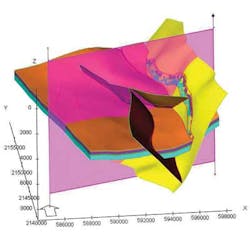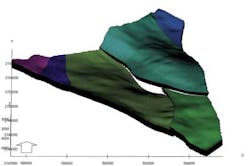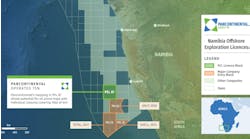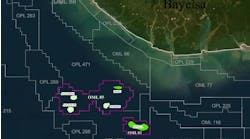Tyson Bridger
Emerson Process Management
For all the focus on EOR (enhanced oil recovery) in offshore operations over the last few years, little attention has been paid to the crucial role reservoir modeling plays in bolstering recovery rates.
Reservoir modeling today is the standard platform to map, understand, and predict oil and gas reservoir behavior. Whether it is seismic interpretation, the building of a structural model, fault and fracture model, or history matching and simulation, reservoir modeling provides operators with crucial information on oil and gas in place and the potential obstacles to accessing them.
Embracing seismic
Reservoir modeling can only be truly effective in increasing oil and gas recovery and providing input to EOR programs if it is able to incorporate 3D and 4D seismic data.
The better that the user is able to incorporate 3D seismic and reservoir heterogeneities and extend the depth of static modeling, the more accurate and realistic the reservoir models are likely to be. In addition to 3D seismic, 4D seismic can be highly effective in mapping and monitoring fluid movements.
All too often, however, the tendency is to simplify, and err on the side of compromise when addressing seismic-derived geological complexities and reservoir heterogeneities. The reasons for this might include the need for an easier workflow or the obvious challenges of modeling seismic. The resolution of the seismic, for example, is often too coarse to resolve the true geometries of the heterogeneities, or uncertainty in depth can make it difficult to represent wells correctly.
While these rationales and the challenges are understandable, there remains a real danger that oversimplified reservoir models will not deliver the vital information operators require to improve recovery rates.
The ability to integrate seismic more tightly into reservoir models can be achieved in a number of ways. Property modeling, for example, is one area where seismic data can be combined with other data, such as well data, to generate accurate and well-constrained reservoir models.
Emerson's reservoir modeling software, Roxar RMS includes an object-based, facies modeling tool that incorporates information derived from seismic directly into the facies model. In this way, data extracted from seismic can be blended with geostatistical tools, such as guide lines and trends, to generate well-constrained sedimentary bodies, a more realistic property model conditioned to well observations, and accurate volume calculations.
Other recent technology developments that enable 3D and 4D seismic data to be incorporated into the reservoir model alongside existing data types, such as geological, geophysical and simulation data, include new seismic inversion and seismic attribute tools.
The inversion tool, for example, allows geoscientists to use seismic data to create a rock property model quickly and accurately using high-frequency information from well logs combined with band-limited frequency information from the seismic data.
In addition, Emerson has a new visualization toolkit to enable modelers to extract maximum value from seismic data through the creation of attributes that more clearly define reservoir structure and guide the user through the facies modeling process.
Key features include importing tools for SEG-Y data sets, and the fast and accurate visualization of seismic data sets of any size through interactive opacity control and color manipulation capabilities.
The net result is a realistic property model conditioned to well observations and with accurate volume calculations – all vital information when looking to extend the life of the reservoir.
Improving North Sea recovery rates
Reservoir modeling plays an important role in increasing recovery rates and supporting EOR programs in the Norwegian North Sea.
One example is Statoil's Statfjord field, one of the oldest producing fields on the Norwegian continental shelf (NCS) that today delivers recovery rates of up to 66% and is scheduled to remain active until 2019.
According to INTSOK, a joint partnership between the Norwegian oil and gas industry and the Norwegian government, Roxar RMS has played a crucial role in generating predictive models for the field and providing input to well intervention, 4D seismic, and water management decisions. Furthermore, any improved oil recovery efforts for the field, such as injecting water, also depend on the predictive model developed.
Statoil's Gullfaks field in the North Sea is another example where recovery rates are now approaching 60%.
What characterizes a strong and effective reservoir model today is one that can build a realistic representation of the reservoir geometry with fluid flow and volumes represented as accurately as possible.
With average global oil and gas recovery rates in the 20% range, the smallest percentage improvements can have a significant impact on both future oil and gas production strategies and operators' bottom lines.
Pemex case
One example of how reservoir modeling contributes to field development and EOR strategies is on Pemex's Kutz field, part of the Cantarell asset, offshore Mexico in the Gulf of Mexico.
The geological complexities and reservoir heterogeneities within the field require the latest in fracture, fault, and object-based facies modeling tools, simulation-friendly grids, and uncertainty analysis features to create a robust and reliable reservoir model on which to make future production decisions.
The field was placed on nitrogen injection in 2000 with production having declined since 2003. There was a need for a 3D model tackle the field's geological complexities, leading to a greater understanding of the asset and its reserves, and helping support updated field development plans based around its 12 existing wells. The reservoir model also can provide input to further simulations and decisions when considering EOR.
With these goals in mind and with its ability to enable direct reference between the model and the 3D seismic, the program helped develop a high resolution modeling grid of 13 million cells using corner-point geometry and incorporating 10 faults. The fault modeling tool also allows geologists and reservoir engineers to quickly and easily analyze the fault sealing properties and fluid flow properties across faults in the 3D reservoir model.
Reservoir properties in the Kutz field were also distributed using 3D modeling tools for both the modeling of the facies and in developing a petrophysics model.
Finally, uncertainty and probability analysis estimated recovery from the field and future production trends with 50 realizations taking place.
The result was a robust and accurate model of the Kutz field that addressed all geological complexities and honored reservoir heterogeneity. The model will be used for the further development of the field, in future simulation processes, and to maximize oil recovery through water, gas, CO2, and nitrogen injection.
Creating an integrated reservoir model
Reservoir models can be fully effective only if they are fully integrated and capture all the field's complexities and heterogeneities.
Another example is in a giant, mature offshore field with a geologically complex setting. Here, an integrated reservoir model was required as a platform to develop an EOR program to help rejuvenate the field – a field that was delivering low production rates despite its good reservoir quality.
In this case, RMS and its Structural and Uncertainty modules developed an integrated, static model for the field comprising more than 100 zones and wells and up to 1,000 different reservoir compartments. The operator has subsequently used the model to support field rejuvenation and EOR strategies.






